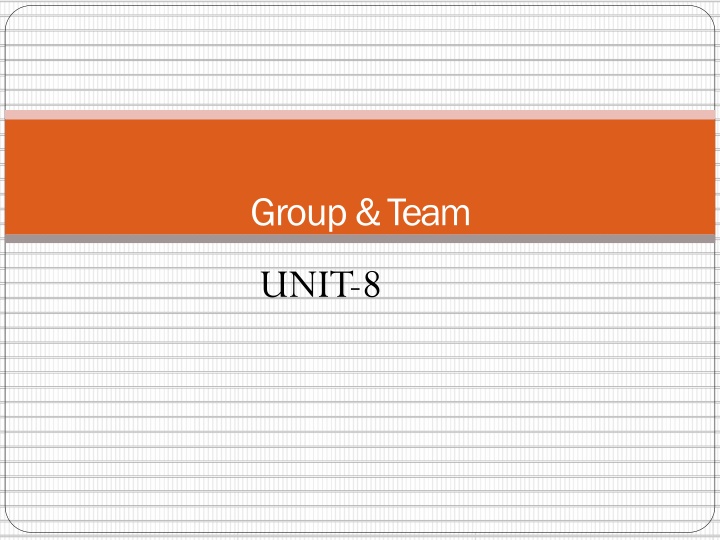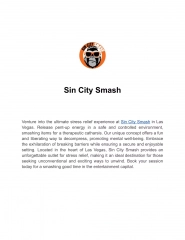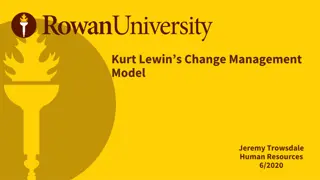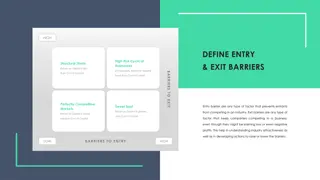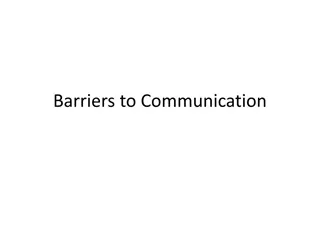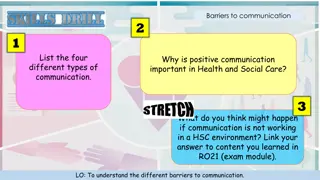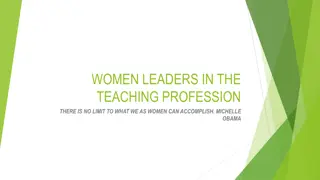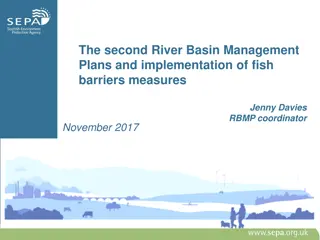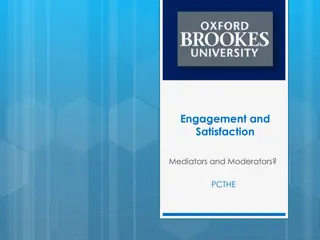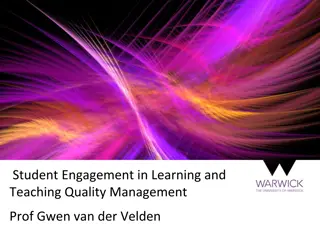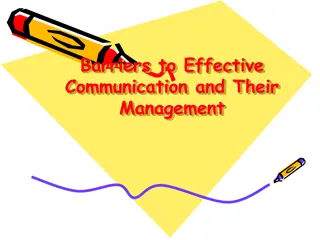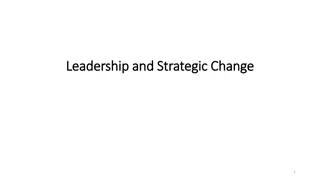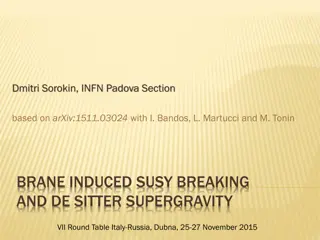Breaking Barriers in Student Engagement for Change
Key barriers to meaningful student engagement and successful student-led initiatives. Discover strategies for supporting diverse student voices, including neurodivergent and marginalized communities. Join discussions and events promoting inclusive learning environments and empowering students with disabilities.
Download Presentation

Please find below an Image/Link to download the presentation.
The content on the website is provided AS IS for your information and personal use only. It may not be sold, licensed, or shared on other websites without obtaining consent from the author.If you encounter any issues during the download, it is possible that the publisher has removed the file from their server.
You are allowed to download the files provided on this website for personal or commercial use, subject to the condition that they are used lawfully. All files are the property of their respective owners.
The content on the website is provided AS IS for your information and personal use only. It may not be sold, licensed, or shared on other websites without obtaining consent from the author.
E N D
Presentation Transcript
Group & Team UNIT-8
Groups &Teams Group - two or more people with common interests, objectives, and continuinginteraction Work Team - a group of people with complementary skills who are committed to a common mission, performance goals, and approach for which they hold themselves mutuallyaccountable
Characteristics ofa Well-Functioning, EffectiveGroup Relaxed, comfortable, informalatmosphere Task well understood & accepted Members listen well &participate People express feelings & ideas
Characteristics ofa Well-Functioning, EffectiveGroup Conflict & disagreement center around ideas or methods Group aware of its operation &function Consensus decision making Clear assignments made &accepted
Difference between Groups and Teams GROUPS TEAMS 1. Strong, clearly focused leader 1. Shared leadership roles. 2. Individual accountability 2.Individual & mutual accountability 3. Purpose is same as a organizat- 3. Purpose is broader than what ional mission, and percolates from the top from top, and accepted by team members, helping to focu on specific goal that team itself delivers. 4. Productivity is largely as a result 4.Productivity is largely due to of individuals in the group. Collective team efforts.
Difference between Groups andTeams GROUPS TEAMS 5. Encourage open-ended discussions & active problem-solving meetings 5. Run efficient meetings 6. Measure performance directly by assessing collective work output. 6. Measure their effectiveness indirectly by their influence on others (e.g. financial perform- -ance of the business, promot- -ions etc) .
Four Stages of GroupDevelopment Forming Storming Norming Performing
Stage One:Forming Definition: Stage 1 teams are generally new teams that are learninghowto work together Characteristics of stage 1 teams: Members tend to be tentativeandpoliteandto havelittle conflict Critical skills and activities: Stage 1 teams need to identify their purpose, developgroup norms, identify group processes, defineroles,buildrelationshipsandtrust Role of facilitator/leader: Stage 1 teams usually need a strongleaderwhocanhelpthe teamgothroughitsforming activities
Storming Definition: Stage 2 teams have moved past the early forming stages and are now encountering some disagreements and/or conflict.This is natural, but teams need to find effective ways to handle conflict before they can move on to stage3. Group characteristics: Members of stage 2 teams tend to exhibit increased conflict, less conformity and jockeying forpower. Critical skills and activities: Stage 2 teams need to learn how to resolve conflict; clarify their roles, power, and structure; and build consensus through re-visitingpurpose. Role of leader(s): Stage 2 teams need leaders and other team members who are willing to identify issues and resolve conflict.
Norming Definition: Stage 3 teams have successfully moved out of the storming stage and are ready to move to a higher level of communication and problem- solving. Group characteristics: Members of stage 3 teams demonstrate an improved ability to complete tasks, solve problems, resolve conflict. Critical skills and activities: Stage 3 teams need to learn to engage in more sophisticated problem-solving and decision-making, continue the use of effective strategies for conflict resolution and take greater levels of responsibility for their roles Role of leader(s): In stage 3, leaders become less directive, team members feel empowered, and multiple leaders emerge
Performing Definition: Stage 4 teams are at the highest level of performance and can process their strengths and weaknesses while accomplishing their goals. Group characteristics: In stage 4, the team takes a flexible approach to roles and structures depending on the task at hand. The team is able to evaluate its effectiveness and views conflict is viewed as an opportunity. Stage 4 teams tend to be energetic, creative, andfun! Critical skills and activities: Stage 4 teams need to hold high expectations for their performance.They often use sub-groups as well as the large group for decision- making and task completion. Teams also recognize the need to ensure that all members are in agreement with the role and purpose of sub-groups. Role of Leader: In a stage 4 team, it s often difficult to identify the leader, because everyone is sharing in leadership.
Types ofgroups Formal groups refer to those which are established under the legal or formal authority with the view to achieve a particular end result and The group is designated by the organizational structure, having work assignments establishing tasks. E.g People making up the airline flight crew, tradeunions.
TYPES OFGROUP Formal Standing TaskGroup TaskGroup
Standing Task / CommandGroup TheStandingTask group are formed by subordinates reporting directly to the particular manager and are determined by the formal organizational chart. E.g. an assistant regional transport officer and his two transport supervisors form a commandgroup.
TaskGroup The task groups are composed of people who work together to perform a task but involve a cross-command relationship. Its boundaries are not located within its immediate hierarchical superior. E.g. for finding out who was responsible for causing wrong medication order would require liaison between ward in charge, senior sisters and head nurse.
Informal Friendship Interest Reference
InterestGroup The interest group involves people who come together to accomplish a particular goal with which they are concerned .Office employees joining hands to go to vacation or get vacation schedule changed form an interest group .
Friendshipgroup The friendship group are formed by people having one or more common features .The people coming from a same college ,martial status, political views or having same language to speak belong to a friendship group.
ReferenceGroup Base of Interest &Friendship. Have in common race, gender, religion, social class, educational level,profession.
What are Different Types of Teams T eam Management Team Problem SolvingTeam Workteam Virtualteam
Theories of groupformation Propinquitytheory. Social Systemtheory Balancedtheory. ExchangeTheory
PropinquityTheory Most basic theory is of Propinquity which asserts that people tend to affiliate with other because ofspatial or geographical closeness.Peoplefromthe sameareaor citytend to bemore boundto eachother.
Theories of groupformation Balance Theory of GroupFormation IndividualX IndividualY Common Attitude& Values Religion Politics Lifestyle Work
Social Systemtheory The other theory of importance is Social System Theory given by Homans.The theory corporate the interrelatedness of elements of activities , interaction , sentiments and the people usually interact to solve problems, reduce tension , attain goals and achieve balance.The workers interacting in this way in organizational setting tends to form groups.
ExchangeTheory The Exchange theory is based on rewards and its cost .The interaction between members is taken as reward and if any relationship which is not rewarding may be costly enough to cause tensions.
Group Cohesiveness
Introduction to Group Cohesiveness Group Two or more people who interact regularly to accomplish a common purpose or goal. Cohesiveness The extent to which members are loyal and committed to the group; the degree of mutual attractiveness within the group.
Attributes of a Cohesive Group The common interests. members share the group goals and have The number of members is relatively small. members are The in constant touch with each other communication. High group loyalty. Members frequently. Members keep themselves attached to the group as they feel that their needs would satisfied by the group and have very effective interpersonal interact among themselves quite
Types of Cohesion Task Cohesion the degree to which members of a group work together to achieve common goals Social Cohesion reflects the degree to which members of a team like each other and enjoy each other s company
Stages of Group Developmen t
Factors that Increase Group Cohesiveness Inter-group competition Personal attraction Favorable evaluation Agreement on Goals Interaction
Factors that decrease Cohesiveness Large group size Disagreement on goals Intra-group competition Domination Unpleasant experiences
The Interaction Between Cohesiveness and Performance Norms
Importance of Group Cohesiveness It has been found by studies that the output of a cohesive group tends to be more uniform than that of the members of the less cohesive group. More cohesive a group is more would be the productivity.
There Are Five Types Of Team Process Team Self Managed Team Cross Departmental Team Or Cross Functional Team Quality Improvement Teams Or Quality Circles Virtual Team
Process team When organization do not have departmental affiliation but function undertake broad organization level process improvement immediately to
Self Managed Team It is a formal mature group of employees who work without a supervisory personnel and responsible for a complete work package. It is process team of employees. These are capable of producing result. They select their own team and evaluate performance It require a total change in organizational structure.
Cross Departmental Or Functional Team Cross functional team are basically to study,analyse,and required to implement. Here it cannot divert the responsibility on others. It means to manage social collaboration and concept creation. It is a small group of interdependent employees from various functional areas of organization . It is formed to handle a specific problem. offer solution that they are
Continue such team becomes essential when the organization. Struggle with a problem that impacts many section of the organization Need to improve the operation or system of process, demanding close coordination from more that one section or department. Reveals that multi skilled person cannot take up the work It require simultaneous application of multifarious skills, expertise, and judgment of person from different section (crossing accomplish the goal. the boundaries) to
Problem solving team It is also called quality improvement team or quality circle or simply work team. It consist of eight to ten members from a common work area. It has a clear and specific focus on process improvement within a single workunit. Organization can establish such team without making major organizational change.
Virtual team A virtual team allows the member to meet without concern for space or time and enables organization to link the workforce together which could not have been done in past. This type of team members are advance in technology,achieve business goal, solve day to day problem, provide feedback, keep all member aware, share success, encourage achievement and so forth. Geographic dispersion never appears as a roadblock.
Interpersonal relationship
DEFINITION .~~ Interpersonal relationship refers to social and emotional interaction between two or more individuals in an environment. ~~ Interpersonal relationship is also defined as the close association between the individuals who share common interest and goals .
IMPORTANCE OR PURPOSES for example.. ~ Interpersonal relationship for an individual - Personal growth and development. - Source of enjoyment. - Sense of security. - Context of understanding. - Interpersonal needs. - Establishing personal identity.
TYPES OF INTERPERSONAL RELATIONSHIP.. ~ These relationships are basically classified based on relational interaction and mutual expectation between communicators. Some of the common types of interpersonal relation are: 1.Friendship 2.Family 3.Professional relationship 4.Love 5. Marriage 6.Brotherhood &sisterhood 7.Casual relationships 8.Acquaintances
PHASES OF INTERPERSONAL RELATIONSHIP 1. ORIENTATION ~Starts with an initial encounter (any sort of conversation). ~Leads to sharing ofresponsibilities ,boundaries . ~Identifying problems ,looking for choices and other several options ,and sharing them . ~Developing a trustworthy relationship by clarifying doubts Sharing perceptions ,conveying needs etc.
SECOND PHASE - IDENTIFICATION ~Approaching and understanding to perceive the feeling of the other person. ~Must avoid all the distractions for the communication to be more effective. ~Identifying the problems and helping others with the resources available. ~As these take place our feelings as well as the listeners, boost up and gives us a feeling of belongingness .
THIRD PHASE - EXPLOITATION ~In this , the listener is made to understand the problem by all available avenue. ~We are supposed to extend for any minimal assistance needed by others to understand the problem . ~Slowly we see that the listener starts exploiting instead of asking help . ~Finally the person is ready to deal with the problems adequately.
FOURTH PHASE RESOLUTION ~Starts with the termination of professional relationship. ~Collaborative efforts have been already met earlier among the communicators. ~No psychological dependence must persist between them if its an outsider or not a well known. ~The relationship must be terminated by just maintaining a healthy and friendly relationship.
